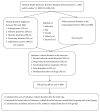The Temporal Relationship between Selected Mental Disorders and Substance-Related Disorders: A Nationwide Population-Based Cohort Study
- PMID: 30402453
- PMCID: PMC6193334
- DOI: 10.1155/2018/5697103
The Temporal Relationship between Selected Mental Disorders and Substance-Related Disorders: A Nationwide Population-Based Cohort Study
Abstract
Introduction. Previous studies have examined the association between specific mental disorders, particularly mood and anxiety disorders, and substance-related disorders; but the temporal link between them remains unclear. This study aimed to examine whether individuals with specific mental disorders, including affective psychoses, neurotic disorders, schizophrenia, personality disorders, and adjustment reaction, have higher risks for subsequently developing substance-related disorders compared to those without. Methods. A large-scale study with longitudinal data was conducted using the Taiwan National Health Insurance Research Database (NHIRD) consisting of 2,000,118 patients' medical records from 2000 to 2009. A total of 124,423 people diagnosed with selected mental disorders and the same number of people without the diagnoses of the selected disorders were identified between January 1, 2001, and December 31, 2006, and followed up for the diagnoses of substance-related disorders till the end of 2009. We estimated the risk for subsequently developing substance-related disorders among patients with the selected mental disorders compared to those without by using Cox proportional hazard models. The cumulative incidence of substance-related disorders was calculated using the Kaplan-Meier method. Results. The risk for developing substance-related disorders in patients with selected mental disorders is about 5 times (HR=5.09, 95% CI: 4.74-5.48) higher than those without after adjusting for potential confounding variables. From the multivariate analyses of subsamples stratified by age, sex, and urban and income levels, we found all adjusted hazard ratios were significantly higher than 1.0, ranging from 2.12 (95% CI: 1.72-2.62) to 14.55 (95% CI: 7.89-26.83). For children and adolescents aged 10-19 years, those with specific mental disorders had 14.55-fold higher risk for developing substance-related disorders in later life compared to their counterparts. Furthermore, patients with personality disorders had the highest risk (HR=25.05). Conclusions. The earlier onset of the selected mental disorders is a potential risk for developing substance-related disorders in later life, particularly for personality disorders. Health professionals should pay more attention to this at-risk population, especially to adolescents with mental disorders.
Figures
Similar articles
-
Insomnia as an independent predictor of suicide attempts: a nationwide population-based retrospective cohort study.BMC Psychiatry. 2018 May 2;18(1):117. doi: 10.1186/s12888-018-1702-2. BMC Psychiatry. 2018. PMID: 29716570 Free PMC article.
-
Risk of Psychiatric Disorders following Irritable Bowel Syndrome: A Nationwide Population-Based Cohort Study.PLoS One. 2015 Jul 29;10(7):e0133283. doi: 10.1371/journal.pone.0133283. eCollection 2015. PLoS One. 2015. PMID: 26222511 Free PMC article.
-
Mental disorders in childhood and young adulthood among children born to women with fertility problems.Hum Reprod. 2015 Sep;30(9):2129-37. doi: 10.1093/humrep/dev172. Epub 2015 Jul 22. Hum Reprod. 2015. PMID: 26202913
-
Exploring Comorbidity Within Mental Disorders Among a Danish National Population.JAMA Psychiatry. 2019 Mar 1;76(3):259-270. doi: 10.1001/jamapsychiatry.2018.3658. JAMA Psychiatry. 2019. PMID: 30649197 Free PMC article.
-
Sleep disorders increase risk of subsequent erectile dysfunction in individuals without sleep apnea: a nationwide population-base cohort study.Sleep Med. 2016 Jan;17:64-8. doi: 10.1016/j.sleep.2015.05.018. Epub 2015 Jun 29. Sleep Med. 2016. PMID: 26847976
Cited by
-
Empowering teachers to screen, guide, and refer schoolchildren with behavioral and mental health problems. A pilot study to promote mental health in Iran.Front Psychiatry. 2022 Aug 4;13:894483. doi: 10.3389/fpsyt.2022.894483. eCollection 2022. Front Psychiatry. 2022. PMID: 35990076 Free PMC article.
-
Exploring substance use disorders and relapse in Mauritian male addicts.Heliyon. 2020 Aug 18;6(8):e04731. doi: 10.1016/j.heliyon.2020.e04731. eCollection 2020 Aug. Heliyon. 2020. PMID: 32904255 Free PMC article.
-
Real-World Evidence for the Association between Heat-Related Illness and the Risk of Psychiatric Disorders in Taiwan.Int J Environ Res Public Health. 2022 Jul 1;19(13):8087. doi: 10.3390/ijerph19138087. Int J Environ Res Public Health. 2022. PMID: 35805746 Free PMC article.
-
Association Between Antibiotic Treatment of Leptospirosis Infections and Reduced Risk of Dementia: A Nationwide, Cohort Study in Taiwan.Front Aging Neurosci. 2022 Mar 23;14:771486. doi: 10.3389/fnagi.2022.771486. eCollection 2022. Front Aging Neurosci. 2022. PMID: 35401144 Free PMC article.
-
Couple Burnout and Partner's Substance-Dependency: Is there any Association?Health Serv Res Manag Epidemiol. 2023 Feb 6;10:23333928221144445. doi: 10.1177/23333928221144445. eCollection 2023 Jan-Dec. Health Serv Res Manag Epidemiol. 2023. PMID: 36760678 Free PMC article.
References
-
- UNODC. World Drug Report 2012. New York, NY, USA: United Nations; 2012.
-
- INCB. Economic consequences of drug abuse. Austria: International Narcotics Control Board; 2013.
-
- Asselmann E., Wittchen H.-U., Lieb R., Höfler M., Beesdo-Baum K. Associations of fearful spells and panic attacks with incident anxiety, depressive, and substance use disorders: A 10-year prospective-longitudinal community study of adolescents and young adults. Journal of Psychiatric Research. 2014;55(1):8–14. doi: 10.1016/j.jpsychires.2014.04.001. - DOI - PubMed
LinkOut - more resources
Full Text Sources



